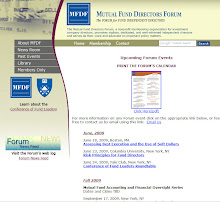The bill requires this new commission to be composed of ten members. In what appears to be a move to give the commision some level of independence and objectivity, the commissioners must be private citizens, none of whom are employed by any federal agency or entity. The members of the commission will be appointed as follows:
- 3 members shall be appointed by the majority leader of the Senate, in consultation with relevant Committees;
- 3 members shall be appointed by the Speaker of the House of Representatives, in consultation with relevant Committees;
- 2 members shall be appointed by the minority leader of the Senate, in consultation with relevant Committees; and
- 2 members shall be appointed by the minority leader of the House of Representatives, in consultation with relevant Committees.
In particular, the committee is required to look into and report about the role of the following in the current financial crisis:
- fraud and abuse in the financial sector, including fraud and abuse towards consumers in the mortgage sector;
- Federal and State financial regulators, including the extent to which they enforced, or failed to enforce
- statutory, regulatory, or supervisory requirements;
- the global imbalance of savings, international capital flows, and fiscal imbalances of various governments;
- monetary policy and the availability and terms of credit;
- accounting practices, including, mark-to-market and fair value rules, and treatment of off-balance sheet vehicles;
- tax treatment of financial products and investments;
- capital requirements and regulations on leverage and liquidity, including the capital structures of regulated and non-regulated financial entities;
- credit rating agencies in the financial system, including, reliance on credit ratings by financial institutions and Federal financial regulators, the use of credit ratings in financial regulation, and the use of credit ratings in the securitization markets;
- lending practices and securitization, including the originate-to-distribute model for extending credit and
- transferring risk;
- affiliations between insured depository institutions and securities, insurance, and other types of nonbanking companies;
- the concept that certain institutions are ‘‘too-big-to-fail’’ and its impact on market expectations;
- corporate governance, including the impact of company conversions from partnerships to corporations;
- compensation structures;
- changes in compensation for employees of financial companies, as compared to compensation for others with similar skill sets in the labor market;
- the legal and regulatory structure of the United States housing market;
- derivatives and unregulated financial products and practices, including credit default swaps;
- short-selling;
- financial institution reliance on numerical models, including risk models and credit ratings;
- the legal and regulatory structure governing financial institutions, including the extent to which the structure creates the opportunity for financial institutions to engage in regulatory arbitrage;
- the legal and regulatory structure governing investor and mortgagor protection;
- financial institutions and government-sponsored enterprises; and
- the quality of due diligence undertaken by financial institutions.
The full text of the Fraud Enforcement and Recovery Act of 2009 is available at: http://frwebgate.access.gpo.gov/cgi-bin/getdoc.cgi?dbname=111_cong_bills&docid=f:s386enr.txt.pdf





